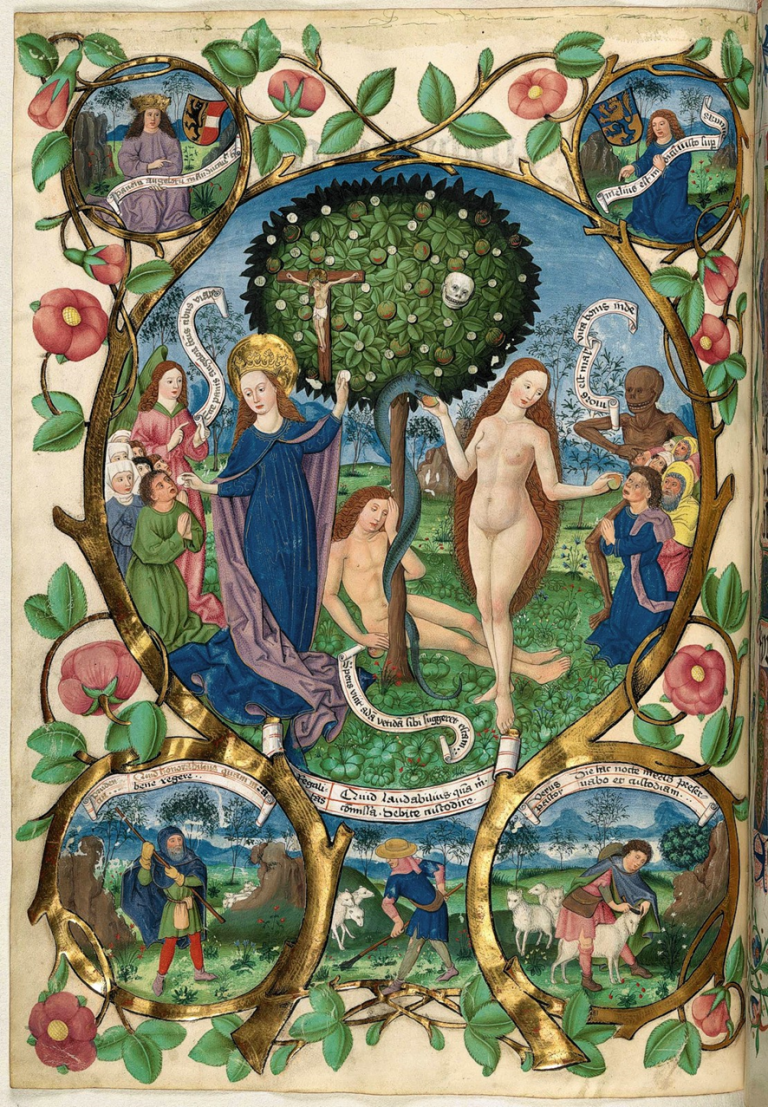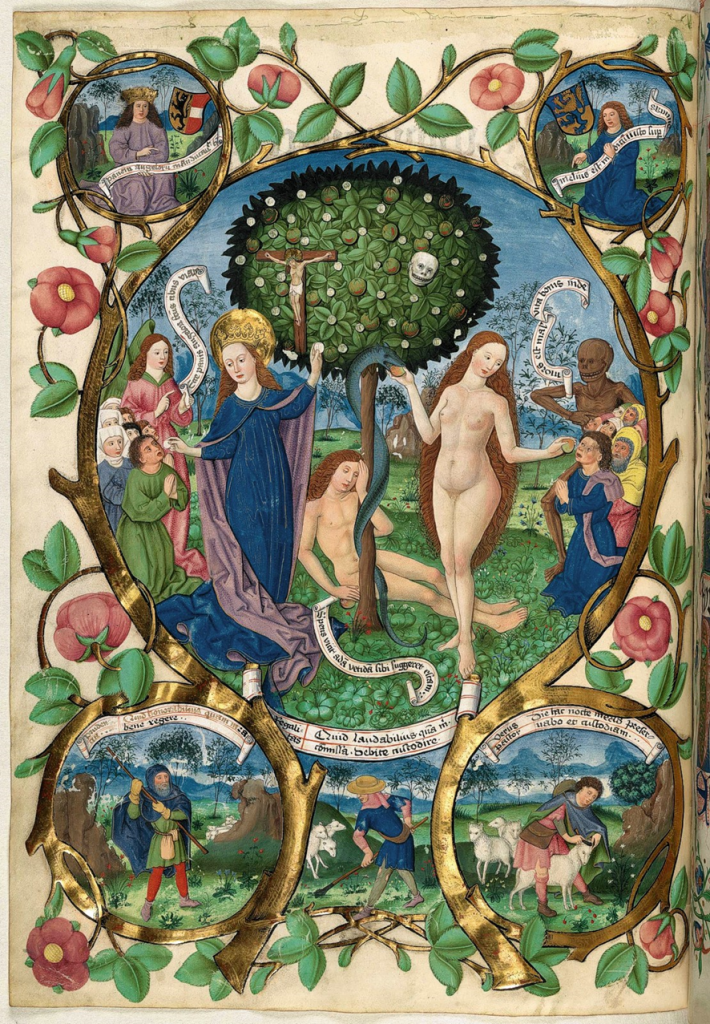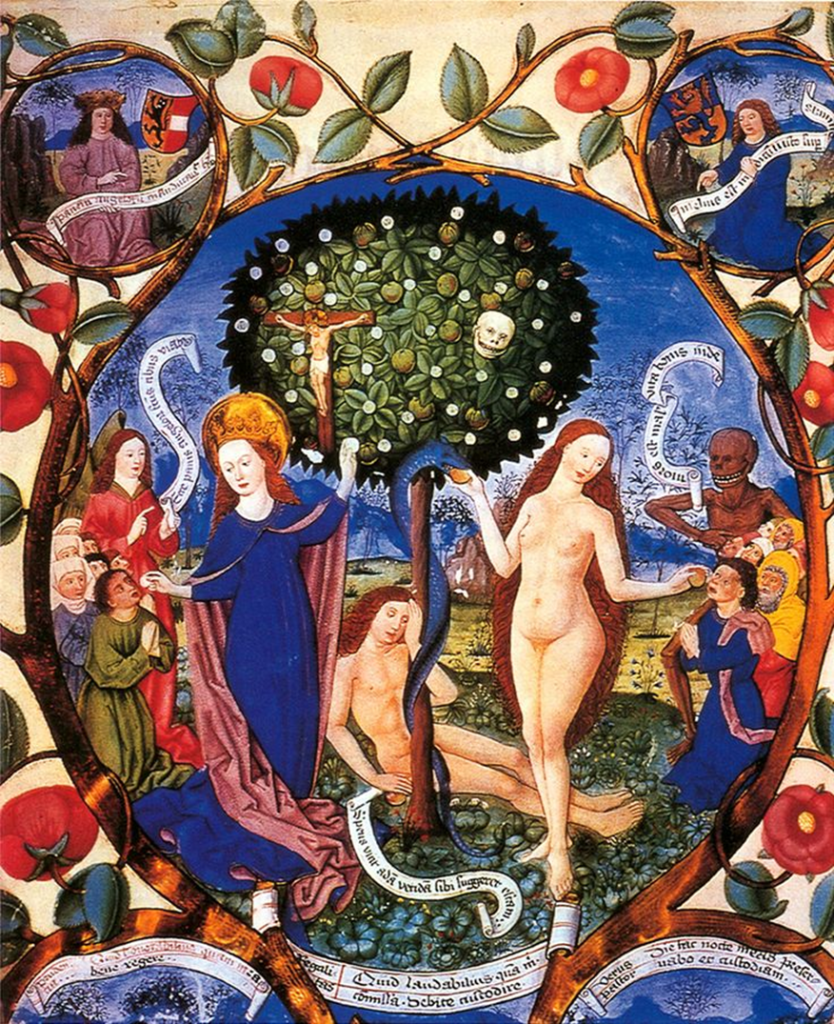

Árvore da morte e madeira da vida – Manuscrito Iluminado de Berthold Furtmayer – Missal de Salzburgo – Bayerische Staatsbibliothek – Alemanha – 1480

Maria, a nova Eva – Gregório de Nissa, sec. IV
“No universo inteiro ouve-se o clamor daqueles que celebram, em uníssono, a festa hodierna. A morte veio por causa de um homem; mas por causa de um homem também veio a salvação. O primeiro homem caiu no pecado; o segundo soergueu aquele que estava caído. A mulher é defendida pela mulher. A primeira abriu o caminho para o pecado; a segunda favoreceu o ingresso para a justificação. Aquela seguiu o conselho da serpente; esta apresentou o matador da serpente e gerou o autor da luz. Aquela, por meio do lenho, introduziu o pecado; esta, ao contrário, sempre por meio do lenho, introduziu o bem. Por lenho, entendo a cruz; o fruto desse lenho é sempre verde e se torna vida imortal para aqueles que o saboreiam.”
Árvore da morte e madeira da vida – Manuscrito Iluminado de Berthold Furtmayer – Missal de Salzburgo (Regensburg) – Bayerische Staatsbibliothek – Alemanha – 1480 – detalhe
Conteúdo: 22 missas para as festas mais importantes do ano eclesiástico na Catedral de Salzburgo
Autores: Os miniaturistas Berthold Furtmeyr (c. 1435/4o-c. 1506); Ulrich Schreier (c. 1430-c. 1490)
Ilustrações: 30 miniaturas de página inteira, 18 páginas inteiras com fotos canônicas.
Patronos: o arcebispo de Salzburgo Bernhard von Rohr (1466-1482), Johannes Beckenschlager (1482-1489) e Friedrich Graf von Schaunberg (1489-1494).
Local: Munique, Bayerische Staatsbibliothek.
Proveniência:
O Missal permaneceu na biblioteca da Catedral de Salzburgo até ser apreendido em 1801 pelos franceses. Na década seguinte, foi transportado de Paris para Munique, onde é guardado desde então.
História:
O Missal permaneceu na biblioteca da Catedral de Salzburgo até ser confiscado em 1801 pelos franceses. Em 1815, foi transferido de Paris para Munique, onde desde então tem permanecido.
Uma das mais belas miniaturas do manuscrito mostra a Árvore da Morte e o Bosque da Vida neste medalhão central.
Assim como a árvore no centro do paraíso era a Árvore da Vida e a Árvore do Conhecimento, que causou a Queda do Homem (Gênesis 2:9), a nova Árvore da Vida plantada no paraíso eclesiástico é pensada para dar frutos tanto para a salvação dos fiéis quanto para a destruição dos infiéis.
Furtmeyr retrata esta concepção da teologia medieval mostrando, em vez da Árvore da Vida, a cruz na folhagem da Árvore do Paraíso – e, também típico, um crânio à direita.
Vários pedaços de frutas caem sobre os seguidores que cercam Eva, que trouxe o pecado para o mundo e Maria, que ajudou a eliminar o pecado original ao dar à luz o Filho de Deus.
As cenas paradisíacas-bucólicas nos medalhões inferiores também refletem a parábola do Bem e do Mal, pois o pastor infiel deixa a sua manada se perder, enquanto o pastor fiel cuida de suas ovelhas, ao tosá-las.
Assim, essa configuração também expressa o mistério da Eucaristia que é celebrada a cada missa de forma simbólica.
O verso na banderola de Adão é retirado da Bíblia dos Pobres, que afirma que a serpente seduziu Adão para comer o alimento proibido.
Desprovido de força, o Pai de Todos os Homens desabou na raiz da árvore.
Os detalhes do tema teológico complicado se fundem nesta composição com sua coloração brilhante e sutil, dando-lhe um caráter solene.
Fonte: Codices Illustres, Ingo E. Walrher and Norbert Wofg, edit. Taschen.
The Salzburg Missal
Date around 1478 – after 1489
Origin Regensburg, Salzburg
Language Latin.
Content 22 masses for the most important feast days of the ecclesiastical year in Salzburg Cathedral Miniaturists Berthold Furtmeyr (c. 1435/40-c. 1506); Ulrich Schreier (c. 1430-c. 1490).
Illustrations: 30 full-page miniatures, 18 full-page canon pictures.
Patron Three consecutive patrons: the archbishops of Salzburg Bernhard von Rohr (1466-1482), Johannes Beckenschlager (1482-1489) and Friedrich Graf von Schaunberg (1489-1494).
Provenance The Missal remained in the library of Salzburg Cathedral until it was seized in 1801 by the French.
In 1815 it found its way from Paris to Munich, where it has been kept ever since.
One of the finest miniatures of the manuscript shows the Tree of Death and the Wood of Life in this central medallion. Just as the tree in the centre of Paradise was both the Tree of Life and the Tree of Knowledge, which caused the Fall of Man (Genesis 2,9), the new Tree of Life planted in the ecclesiastical Paradise is thought to bear fruit both for the salvation of the faithful and the destruction of the unfaithful.
Furtmeyr depicts this conception of medieval theology by showing, rather than the Tree of Life, the crucifix in the foliage of the Tree of Paradise – and, also typically, a skull to the right. Various pieces of fruit drop down on the followers surrounding Eve who brought Sin into the world and
Mary who helped to wipe out the original sin by giving birth to the Son of God.
The paradisiacal-bucolic scenes in the lower medallions also reflect the parable of Good and Evil in that the unfaithful shepherd lets his herd go astray while the faithful shepherd cares for his animals – here by shearing them.
Thus this configuration also expresses the mystery of the Eucharist that is celebrated at every mass in symbolic form.
The verse in Adam’s banderole is taken from the Biblia Pauperum (Bible of the Poor) which maintains that the snake seduced Adam to eat the forbidden food.
Devoid of strength, the Father of Mankind has sunk down at the root of the tree. The details of the complicated theological theme fuse in this composition with its shiny, finely shaded colouring, thus lending it a solemn overall character.
Source: Codices Illustres, Ingo E. Walrher and Norbert Wofg, edit. Taschen.
Produzido por

Consulte a Agenda do Museu a partir de 2025 e o visite quando receber sua confirmação de visita em seu email ou whatsapp.
Por se tratar de um museu particular, é necessário se cadastrar na Comunidade MuMi e customizar sua visita.
Criação e Tecnologia: Clayton Tenório @2025 MuMi – Museu Mítico